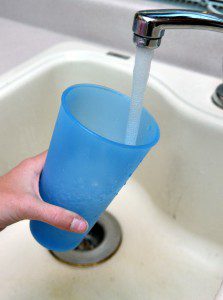WESTFIELD–Part of what caused the water ban in Westfield this week was because of pollutants in the water that has shut down three wells, but to many it is unclear what these pollutants are and what will happen.
The pollutants, known as PFOS and PFOA, were initially responsible for the shutdown of two wells in Westfield after a health advisory released in May 2016 from the EPA lowered the acceptable standard of the amount of these two inorganic compounds in drinking water. Now, after a third well was shut down and drought conditions continue, a water ban has been put in affect.
The water produced from these wells, depending on the time of year, can be as high as 45 percent of the water used in the city, the Westfield Water Commission said during their emergency meeting Thursday.
“It’s inorganic material and it comes from a lot of sources,” David Billups, Westfield Water Resources superintendent, said. “They’re used to make carpets, clothing, fabrics for furniture, paper packaging for food, cookware, anything that’s resistant to water or stains.”
“They’re also used for fighting oil and gas fires and firefighter training in airfields,” he said.
This is important to note, since the first two wells that were shut down, numbers seven and eight, were located adjacent to the Barnes Municipal Airport.
However, Billups also pointed out that there was a rug cleaning business in that area, along with other industrial businesses. Billups declined commenting on whether the incidence of PFOS and PFOA in the wells was related to any of the places listed above.
Billups said that the EPA had lowered the acceptable amount of PFOS and PFOAs in water significantly, which is part of the reason for the ban, as well.
“The EPA came out with a new limit–it’s actually called a health advisory–of 70 parts per trillion,” he said. “The old limit was 600 parts per trillion, and that put the first two wells over.
“Then we got test results back that show well two is barely over the limit.”
Well two is located on Union Street, near the bottom of Springdale Road, Billups said.
According to the EPA website, the risk of PFOS and PFOAs in water is related to possible health effects in humans:
“EPA’s health advisories are based on the best available peer-reviewed studies of the effects of PFOA and PFOS on laboratory animals (rats and mice) and were also informed by epidemiological studies of human populations that have been exposed to perfluoroalkyl substances (PFASs). These studies indicate that exposure to PFOA and PFOS over certain levels may result in adverse health effects, including developmental effects to fetuses during pregnancy or to breastfed infants (e.g., low birth weight, accelerated puberty, skeletal variations), cancer (e.g., testicular, kidney), liver effects (e.g., tissue damage), immune effects (e.g., antibody production and immunity), thyroid effects and other effects (e.g., cholesterol changes).
Billups was clear however, that there was no risk to the public at this time.
“There will be no danger to the public at this time,” he said. “We removed these wells because of the level, but overall the system is below the limits and we will continue to work on it.”
The wells affected are part of the Barnes Aquifer, which provides roughly 1.2 billion gallons of water to portions of the cities of Westfield, Easthampton and Holyoke, as well as part of the town of Southampton. However, due to the flow of the aquifer, Billups said that the contamination isn’t likely to spread to other communities.
“The aquifer goes north to south and the airport sits on top of the aquifer and the contamination is under the airport,” he said.
Billups said that there are ways to remove the compounds from water, which the city is currently exploring.
“Right now, there are two approved methods, one is reverse osmosis which you really can’t do on a large scale,” he said. “The other is activated carbon. We run the water through activated carbon and then you have to chlorinate it and then it’s good to go.”
Billups said that one water treatment plant currently exists in the city with the activated carbon filtration system, which is the Shaker Road water treatment facility. However, due to location this facility wouldn’t be able to filter the affected wells, since it is not close enough.
Instead, Billups said that they are investigating building at least two new water treatment facilities, with one for wells seven and eight, as well as another for well two. He said that they will be focusing on wells seven and eight first, since they are “high-yield wells.”
Fortunately, Billups said he doesn’t see the remaining wells becoming affected. He said that wells three through six are part of smaller aquifers.
Billups said that it was unclear when the facilities will be built, especially since they are still trying to figure out the proper size of vessels they will need for the project. However, once the plans become finalized he said that it may be a year for them to finish construction.
Until then, Billups said that there may be some mobile trailers brought in to be used as temporary filtration systems, in order to get the wells back online.



